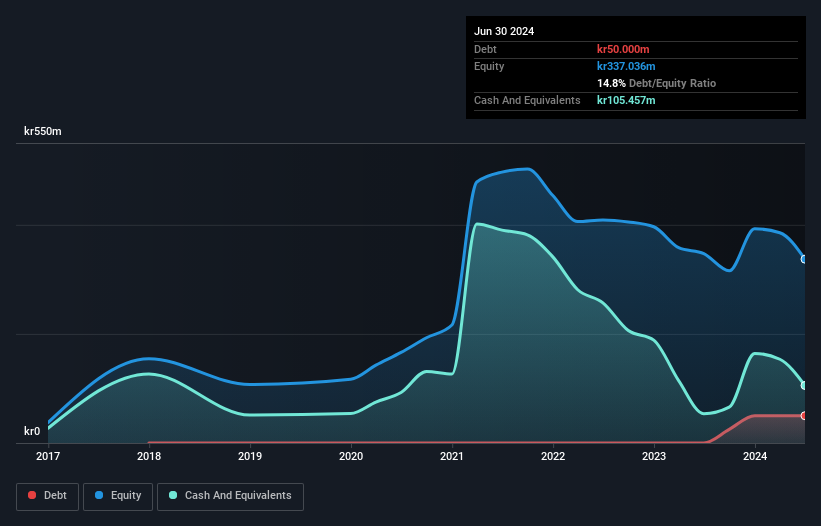Howard Marks put it nicely when he said that, rather than worrying about share price volatility, 'The possibility of permanent loss is the risk I worry about... and every practical investor I know worries about.' So it might be obvious that you need to consider debt, when you think about how risky any given stock is, because too much debt can sink a company. We note that Huddly AS (OB:HDLY) does have debt on its balance sheet. But is this debt a concern to shareholders?
When Is Debt Dangerous?
Debt is a tool to help businesses grow, but if a business is incapable of paying off its lenders, then it exists at their mercy. In the worst case scenario, a company can go bankrupt if it cannot pay its creditors. However, a more usual (but still expensive) situation is where a company must dilute shareholders at a cheap share price simply to get debt under control. Of course, the upside of debt is that it often represents cheap capital, especially when it replaces dilution in a company with the ability to reinvest at high rates of return. When we think about a company's use of debt, we first look at cash and debt together.
See our latest analysis for Huddly
What Is Huddly's Net Debt?
You can click the graphic below for the historical numbers, but it shows that as of June 2024 Huddly had kr50.0m of debt, an increase on none, over one year. But it also has kr105.5m in cash to offset that, meaning it has kr55.5m net cash.

A Look At Huddly's Liabilities
We can see from the most recent balance sheet that Huddly had liabilities of kr125.4m falling due within a year, and liabilities of kr110.0m due beyond that. On the other hand, it had cash of kr105.5m and kr44.2m worth of receivables due within a year. So its liabilities outweigh the sum of its cash and (near-term) receivables by kr85.7m.
While this might seem like a lot, it is not so bad since Huddly has a market capitalization of kr338.8m, and so it could probably strengthen its balance sheet by raising capital if it needed to. But we definitely want to keep our eyes open to indications that its debt is bringing too much risk. While it does have liabilities worth noting, Huddly also has more cash than debt, so we're pretty confident it can manage its debt safely. There's no doubt that we learn most about debt from the balance sheet. But it is Huddly's earnings that will influence how the balance sheet holds up in the future. So when considering debt, it's definitely worth looking at the earnings trend. Click here for an interactive snapshot.
Over 12 months, Huddly made a loss at the EBIT level, and saw its revenue drop to kr174m, which is a fall of 49%. To be frank that doesn't bode well.
So How Risky Is Huddly?
We have no doubt that loss making companies are, in general, riskier than profitable ones. And the fact is that over the last twelve months Huddly lost money at the earnings before interest and tax (EBIT) line. Indeed, in that time it burnt through kr141m of cash and made a loss of kr169m. With only kr55.5m on the balance sheet, it would appear that its going to need to raise capital again soon. Overall, we'd say the stock is a bit risky, and we're usually very cautious until we see positive free cash flow. The balance sheet is clearly the area to focus on when you are analysing debt. However, not all investment risk resides within the balance sheet - far from it. Case in point: We've spotted 5 warning signs for Huddly you should be aware of, and 4 of them are potentially serious.
At the end of the day, it's often better to focus on companies that are free from net debt. You can access our special list of such companies (all with a track record of profit growth). It's free.
Valuation is complex, but we're here to simplify it.
Discover if Huddly might be undervalued or overvalued with our detailed analysis, featuring fair value estimates, potential risks, dividends, insider trades, and its financial condition.
Access Free AnalysisHave feedback on this article? Concerned about the content? Get in touch with us directly. Alternatively, email editorial-team (at) simplywallst.com.
This article by Simply Wall St is general in nature. We provide commentary based on historical data and analyst forecasts only using an unbiased methodology and our articles are not intended to be financial advice. It does not constitute a recommendation to buy or sell any stock, and does not take account of your objectives, or your financial situation. We aim to bring you long-term focused analysis driven by fundamental data. Note that our analysis may not factor in the latest price-sensitive company announcements or qualitative material. Simply Wall St has no position in any stocks mentioned.
About OB:HDLY
Huddly
A technology company, creates tools for team collaboration in Europe, the Middle East, Africa, the Asia Pacific, and the Americas.
Excellent balance sheet with slight risk.
Similar Companies
Market Insights
Community Narratives



